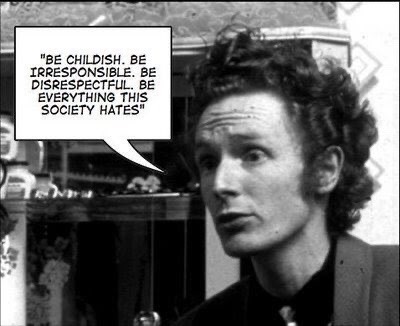#Malcolm mcclaren
Text

BUSINESS CARD FROM VIVIENNE WESTWOOD & MALCOLM MCCLAREN'S SEX STORE (1970s)
#1970s#70s london#chelsea#punk#early punk#sex store#seditionaries#Malcolm mcclaren#mcclaren westwood#westwood#westwood mcclaren#vivienne westwood#sex pistols#british punk
45 notes
·
View notes
Text

Malcolm McClaren and Vivien Westwood inside Let It Rock in Kings Road, London in 1972.
5 notes
·
View notes
Text
Got the special edition of Classic Pop, which this time was Classic Pop Presents 1984 (part of a series of them working through the eighties year by year).
It included features on Purple Rain and some of the hit albums of the year like The Age of Consent (Bronski Beat), Like A Virgin (Madonna), Diamond Life (Sade), Make It Big (Wham), and Welcome to the Pleasuredome (Frankie Goes To Hollywood). plus there was a great feature titled The Year Pop Came Out that featured 1984's Gayest Hits (which includes so many of my personal favourites that I really do think it explains a lot).
Their top 40 singles of 1984 included some great choices like Madame Butterfly (Malcolm Mcclaren), The Glamorous Life (Sheila E.) with Purple Rain at number 2 and Smalltown Boy by Bronski Beat taking the top spot.
I'm looking forward to them covering the rest of the eighties.
#classic pop magazine#purple rain#bronski beat#madonna#sade#wham#frankie goes to hollywood#sheila e.#prince#malcolm mcclaren
1 note
·
View note
Text
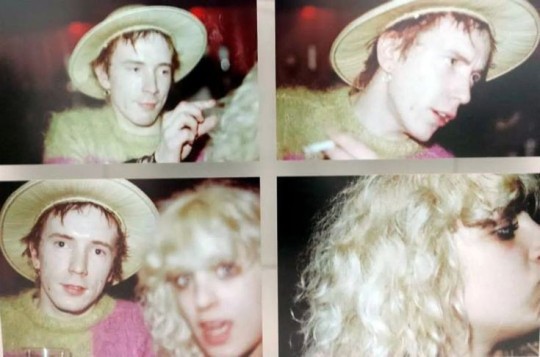
Nancy Spungen and Johnny Rotten
Photo Nancy Spungen and Johnny Rotten at Ivanhoe, Manchester Road, Huddersfield, 1977.
photo history:
It was 1977, I had just finished filming Derek Jarman’s ‘Jubilee’ when I decided to visit an old friend of mine – Rae Spencer-Cullen – in New York. In addition to acting I also used to write articles for the glossy punk magazine “Delux” edited by Willy Daly and Duncan Fallowell. Upon mentioning I was off to New York, Duncan exclaimed, “Why don’t you try and get an interview with Andy Warhol for the magazine?”
I arrived in New York and rang ‘The Factory’. I was immediately invited down to meet Warhol as he was very interested to find out about Jubilee and the Punk movement in England. During the course of our meeting, he asked me if I knew the Sex Pistols, and if so, whether I could get an interview with them for his magazine ‘Interview’.
Arriving back in England a few weeks later, I contacted Malcolm McClaren asking if it would be possible to interview the Band. He said it was fine, but I had better get a move on as they were off on tour to America in a few days and were about to play their last gig in the UK at Ivanhoe’s in Huddersfield. They were playing a matinee and evening show as part of a benefit for families of striking firemen, the gig was to take place on Christmas Day 1977. At this time the location of any gigs the Pistols played were kept secret until the very last minute, in order to avoid trouble and cancellation.
I drove up to Huddersfield on Christmas morning and witnessed an electrifying concert. I spent a lot of time backstage where several of these pictures were taken. The band were incorrigible, Nancy Spungen stood behind me trying to set light to my hair – it was Johnny Rotten who finally stopped her. Sid Vicious was completely out of it, along with the other members of the band, excluding Rotten. The band poured beer in my tape recorder, which virtually stopped it from working and referred to Andy Warhol the whole way through as ‘Andy Arsehole’. Remarkably, I did manage to complete the interview but, unsurprisingly perhaps, Warhol decided not to use it. I sold it to Heathcote Williams for his magazine ‘It’.
Huddersfield was the last concert that the Sex Pistols played in England. In February 1978 Rotten left the band and within a year both Nancy Spungen and Sid Vicious were dead.
In 2008 the remaining Sex Pistols reformed and played a concert at the Brixton Academy.
Photographs taken by Jenny at the Concert were shown at the Rock Shutter Exhibition – ‘Best 500 Rock and Roll Photographs’ in Las Vegas, USA and prints of these are now highly collectable.
14 notes
·
View notes
Text
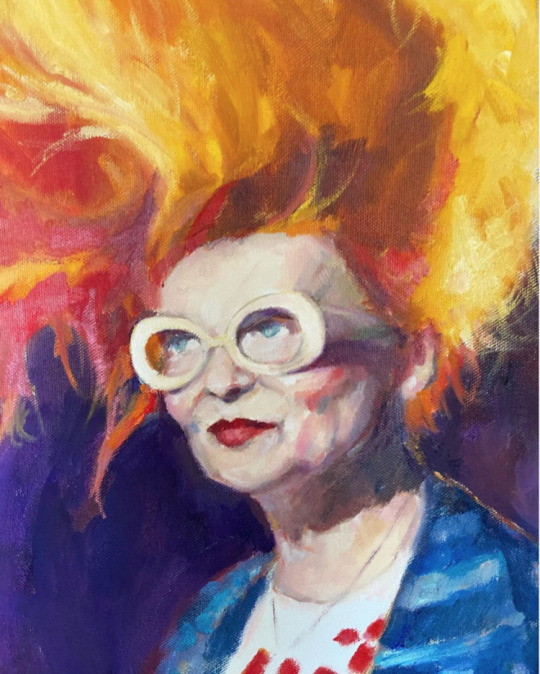
Vivienne Westwood by Allison Adams
Dame Vivienne Westwood (1941-2022) was a British fashion designer and businesswoman, largely responsible for bringing modern punk and new wave fashions into the mainstream. In 1970s London, she and her partner, music manager Malcolm McClaren sold customized t-shirts, ripped up and embellished with anti-establishment slogans and trousers with long straps attached, hugely popular with the growing punk rock scene. Over time she started her own line, using classic elements from historical costumes and traditional tartan patterns, and though she was constantly ridiculed by the British press, she managed to eventually become one of the top fashion designers in the world, even being given the royal honor of the title: Dame Commander of the Order of the British Empire (DBE). Delightfully ironic, she stayed true to her punk roots for her entire career. She continued to design and build her fashion empire involved in the theatrics of her shows and brand, and she managed to balance this with passionate climate activism, a message she wove into her designs and products.
#Allison adams#vivienne westwood#art#artwork#female portrait#businesswomen#fashion#fashion designer#herstory#women in history#female artists#punk#irl women/girls
8 notes
·
View notes
Text
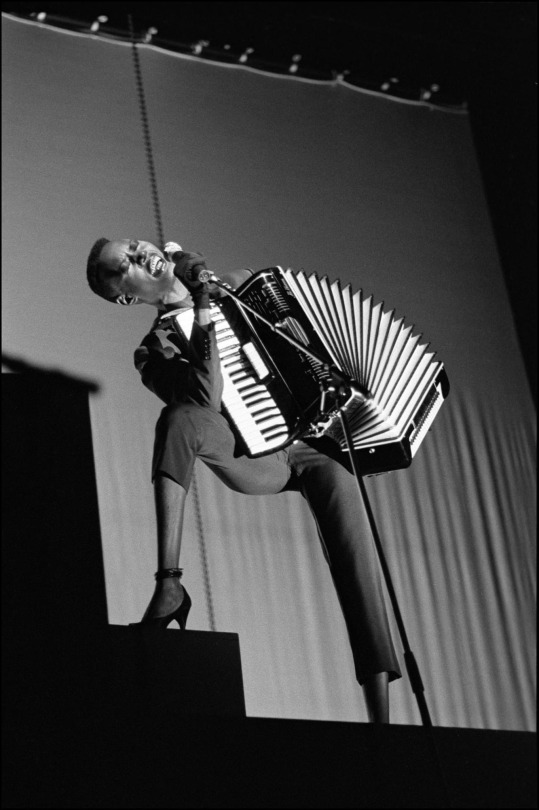
Photo of Grace Jones, Drury Lane Theatre, London, England, 10th October 1981 by David Corio
* * * *
The haters of Madonna are saying No Band on stage is just Karioke
I have posted many times the Malcolm McClaren Keynote " Karaoke Culture "
Having seen Grace Jones in 1981 and the songs of her Nightclubbing album were all in my Club for Heroes DJ Sets. Chris Blackwell came in many times asking me what is this song ?
"Private Lives" by "The Pretenders" "Nightclubbing" By Iggy Pop "Warm Leatherette" by The Normal and his own Roxy Music Love is the drug 12" were all big tracks. Seeing Grace jones performance her clothes her stage show and the stage set of 26 TV's . TV's later I bought them all for the stage set of The Playground Club with a Video Mixer Bruno. We showed Videos and mixed the audio like they were records. Madonna presented a stage show and Like Grace Jones the performance and the performers was not about a band it was about Madonna. Who wrote all her music and who . Grace Jones was before Madonna and before Lady Gaga as a performer and she continued the concept that the Drag Queens used lip sync to old songs that I saw at ROMY HAAG club in Berlin . A floor show was not about who could sing , it was about the whole show , costumes and dancers lights and costumes. Madonna carried that on with her own music in sound and vision.
I was there it was amazing , Inspirational and this review By Paul Morley mates with Trevor Horn of her Hampton Court 2022 says " ‘pop music has been tattooed with Jones’s influence for 45 years.’"
[Rusty Egan]
14 notes
·
View notes
Photo

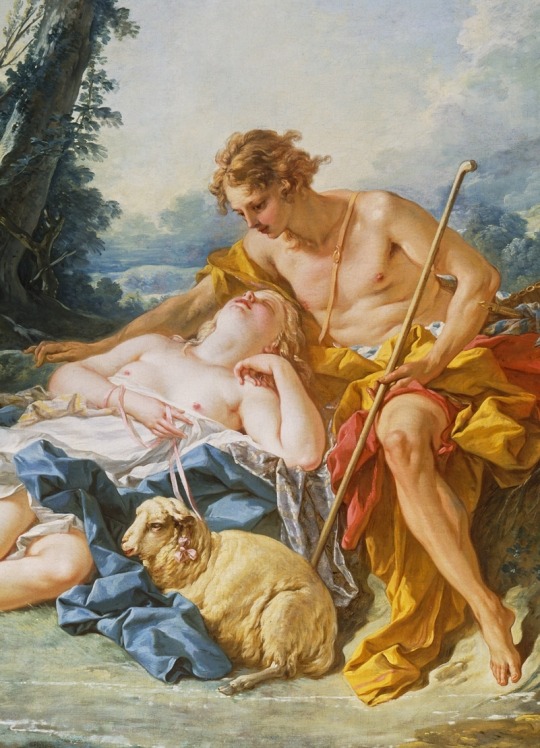

Corset from the “Portrait” Collection & Jeans from the “Cut & Slash” Collection
Vivienne Westwood
Fall/Winter 1991 & Spring/Summer 1991
At the time of this acquisition, Vivienne Westwood is regarded as the doyenne of British fashion. Controversial, acclaimed, eccentric, classic, punk, confronting and essentially British all describe Westwood's work. Opening a shop at 430 King's Road Chelsea, London with then partner Malcolm McClaren in 1971, Westwood sold her own designs through this shop, later called the World's End. Her early work of the 1970s harked back to fifties classic fashion at a time when hippy ideas were dominating fashion. Her work became increasingly associated with and inspired by the punk movement, epitomised by her relationship, through McClaren, with the punk rockers, the Sex Pistols, who first performed in 1976. She became their costume designer. Gene Krell describes Westwood as 'punk's prototype and greatest showpiece.' After punk, her interests became more historical, adapting and reinterpreting materials and designs into her own style.
The corset was designed for her Portrait collection AW 1991. Westwood's revival of the corset ws one of her most important fashion ideas of the 1990s. Her corsets were modelled on the 18th century style, flattening and raising the bosom. The corset is photographically printed with a detail from Boucher's 'Daphnis and Chloe (Shepherd watching a sleeping shepherdess, 1743-5)' in the Wallace Collection, London.
The jeans with detachable satin codpiece come from Westwood's Cut and Slash collection, Spring Summer 1990-1991. With this collection, Westwood explored clothing that was androgynous. Inspired by historical portraits of men in slashed costume wearing codpieces, Westwood employed the 17th century technique of slashing she had studied at the V and A. Westwood slashed demin, cotton, satin and silk for the collection and achieved the effect in various ways: the large slashes were hand-cut while the smaller, regular cuts were made using a broderie anglais programme in which embroidered sections were cut, but the embroidery itself was omitted. The jeans with detachable codpiece were worn by the donor with a Westwood corset.
Her style is individualistic and can push the boundaries of acceptability. While her range is extremely wide, her clothes bear her signature emphasis on intricate craftsmanship. Her work draws from a wide range of influences, particularly historical periods and collections, like the Wallace Collection. In 2004, the Victoria and Albert Museum held a major retrospective of her work. Each collection has a theme and title. She produces a range of collections twice a year, currently: gold label, red label, man and anglomania. Her range of accessories is extensive: bags, women's and men's shoes, jewellery and two lines of perfumes (Boudoir and Libertine). Her works promote a sumptuous and glamorous yet rebellious and challenging take on British identity, gender and politics. She said 'I am English, and I parody the English, with the hope that my clothing will have a international significance.'
Powerhouse Museum (Object No. 2006/96/12 & Object No.2006/96/7)
#corset#vivienne westwood#1990s#fashion history#vintage fashion#20th century#1991#fall#winter#spring#summer#art#art history#denim#cotton#lycra#england#powerhouse museum
217 notes
·
View notes
Text
The Pistols
The Sex Pistols sucked, only sounded half decent in the studio. They were a boy band to sell fashion clothes designed by Vivienne Westwood at Malcolm Mcclarens SEX shop in London. What I do like about them is what they caused to happen. If you look at who was in those first audiences, so many of those folks went on to start their own music careers and have since been inducted into the Rock and Roll hall of Fame! Their greatest contribution was to inspire others on to their own paths to greatness! John Lydon is an asshole and will always be one but you cant deny the things he inspired!
3 notes
·
View notes
Text
yohji yamamoto
contemporary designer at the forefront of Deconstruction processes.
Yohji Yamamoto is a master of the deconstructed style that has revolutionized fashion in the last 30 years. A style capable of deconstructing classic fashion with lines of pure poetry. Now it is he himself who has traced the way to revolutionize style, alter stereotypes, destabilize our concepts of clothing.

In 1972, a revolution stirred as Yohji Yamamoto began making menswear-inspired clothes for women in his hometown of Tokyo. Having spent a couple of years wandering around Europe, where he was awarded a scholarship to study couture dressmaking in Paris, he began to unpick every seam he had been taught to hand-stitch. Channelling the beauty of darkness and poetic destitution, he created enveloping silhouettes in purposefully aged fabrics in only the deepest, darkest shades of black, worn with pallid bare faces, flat shoes, and jauntily uneven hems and finishings.

A young Yamamoto-san had visited Vivienne Westwood and Malcolm McClaren’s epicentre of punk, Sex, a couple of years prior in London with his then-girlfriend Rei Kawakubo. It sparked a desire to destroy everything he was ever taught in order to sow the seeds for something new. “You will only be able to oppose something and to find something of your own after travelling the long road of tradition,” he explained in his own words.
The Yohji is always recognizable: large pockets clearly visible, revisited collars, oversized volumes, cuffs with doubled volumes, kimono sleeves, long coats open as if they were imperial capes and military prints that gain softness.
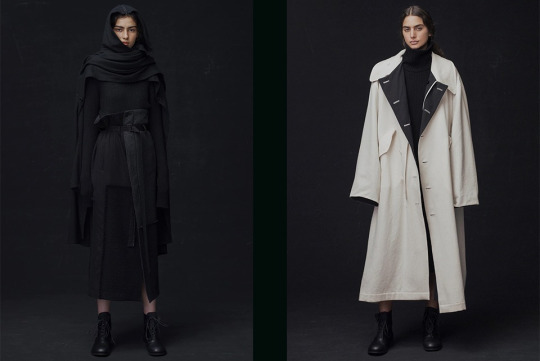
Since the establishment of Y's Company Ltd. in 1972, Yohji Yamamoto continues to spread his revolutionary, ever-widening sphere of influence in fashion, driven by his rebellious spirit.
Ever since the first presentation of his brand YOHJI YAMAMOTO in 1981 during Paris fashion week, each collection is greeted by the world with great uproar and applause. The designer entered into collaboration with adidas as Creative Director of Y-3 in 2002. He has also designed costumes in various fields, including films of directors Wim Wenders and Takeshi Kitano, opera by Wagner, and the performed by Tanztheater Wuppertal and choreographed by Pina Bausch.
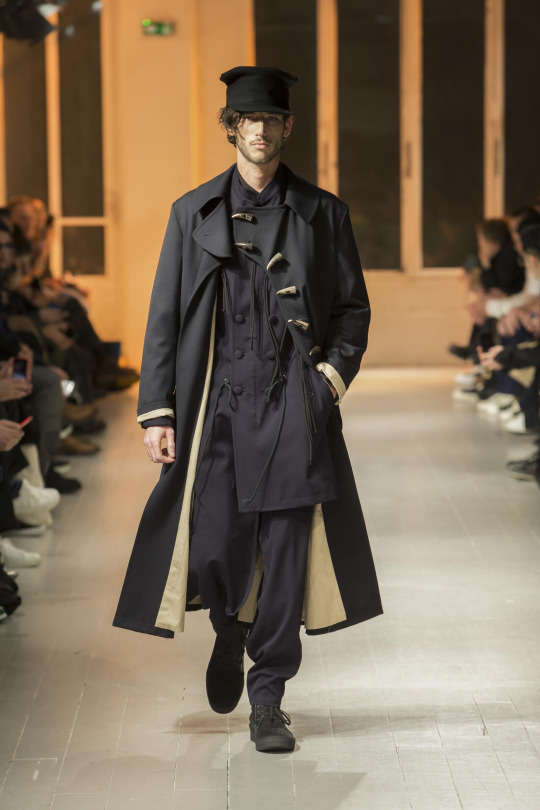
0 notes
Text

VIVIENNE WESTWOOD & MALCOLM MCCLAREN CASH FROM CHAOS 'WORLD'S END' TAG SHIRT
#VIVIENNE WESTWOOD#malcolm mclaren#seditionaries#Westwood/Mcclaren#1970s#worlds end#Cash from chaos#leopard print#leopard
3 notes
·
View notes
Text
PEOPLE IN PUNK PAGES 19&20
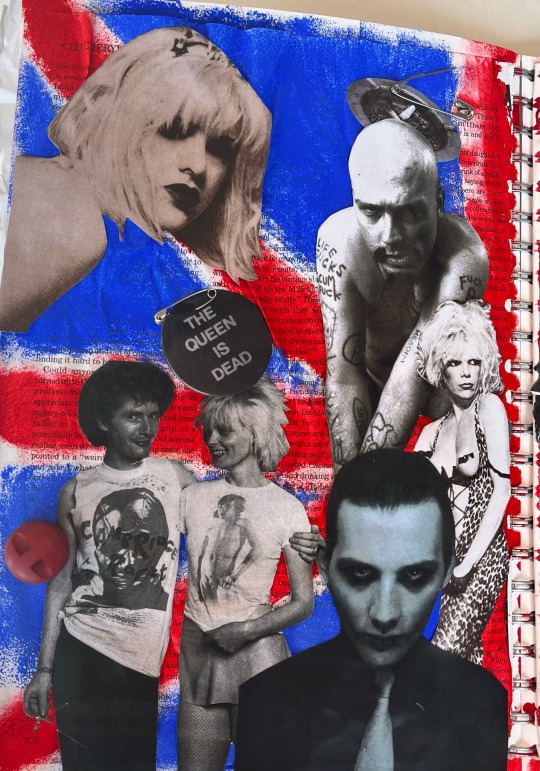
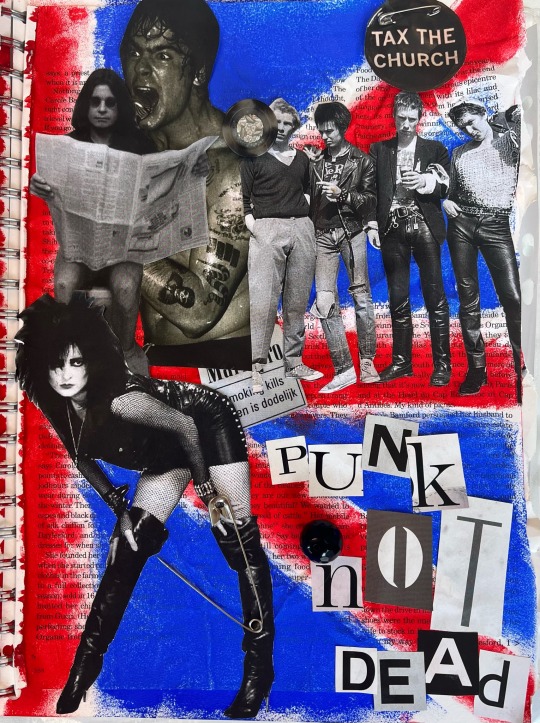
I decided to create a double page spread of some of the most influential people in the punk rock movement. This includes people such as, Iggy Pop, Vivienne Westwood, Malcolm McClaren, Wendy ‘O’ Williams and many more.
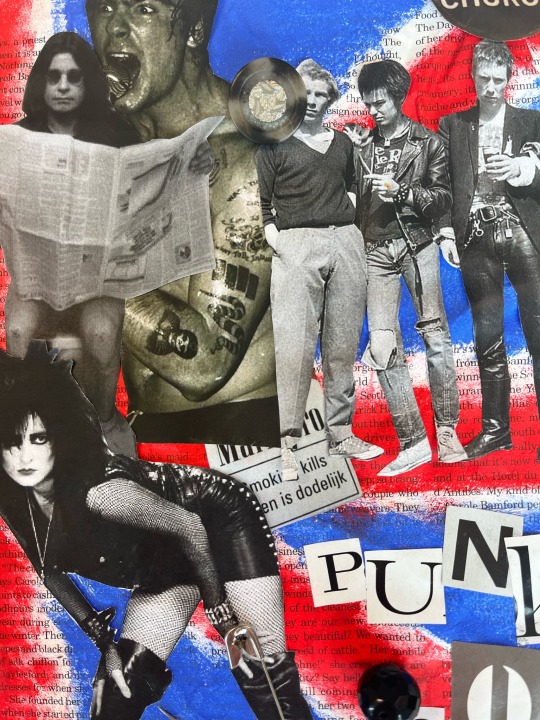
These people had the most influence on the punk rock scene whether that be the things they were doing, what they were fighting for or the music they produced they all had a role to play in the punk scene.
Tuesday 21 March
1 note
·
View note
Text
Hip Hop: Culture Or Commodity

It’s 2023. We’ve entered the 50th year of hip-hop culture.
Or have we? Is it more appropriate to say, “We’ve entered the 50th year of hip-hop commodity?”
Like many of you, since childhood, I’ve embraced the narrative that DJing, MCing, breaking and graffiti were born out of the tenets of peace, love, unity and having fun.
But, today, as a grown man who’s well-read, who has cultivated the power of discernment, and who thinks his own thoughts, I question if that old narrative was merely a marketing strategy; one which was sold to me, and that I “bought,” as a young, impressionable kid, growing up in Queens, NY.
I raise this question, because much of the culture today, while designed to look authentic, seems to merely be an aspect of one, or another, marketing strategy.
Let me explain what I mean, via my own story:
I was born on May 14, 1972. I’m one year older than the culture. Of course, I wasn’t there, watching Kool Herc at the first “Back To School Jam,” on Sedgwick Ave in the Bronx, on August 11, 1973.
But thanks to my older brother, John, by the age of 5, my hip-hop education had begun. Granted, what I was learning about through my bro’s tutelage actually had no name in 1977. It was just this thing some of us called “Getting Down,” or “Going Off,” or “Jamming.”
But, in fact, it was an art renaissance, taking place in the Bronx, and spilling over into the surrounding boroughs of Queens, Brooklyn, and Manhattan.
youtube
By 1979, at age 7, I was all in.
“Robert: You hear that sound? Ziggaziggazigga? That’s GrandWizzard Theodore scratching the record. Papi doesn’t get back from work for another couple of hours. Let’s turn on his turntables so I can teach you how to scratch before he gets home.”
Or “Robert, I’m taking you with me to Saint Joan of Arc Church. The head priest is gonna let us break inside their recreation room.”
I was learning about this creative phenomenon, exclusive to New York, taking place inside my city, my community, my neighborhood, and with my friends.
youtube
Thanks to programs like HOT TRACKS — which played music videos from artists like RUN DMC and Malcolm McClaren feat. The World’s Famous Supreme Team — by 1982, the rest of America got exposed. People outside of NYC began seeing the faces and hearing the voices of my ghetto heroes.
“Ghetto,” because Kool Herc, Grandmaster Flash, GrandWizzard Theodore, Grand Mixer DST, Tony Tone, Charlie Chase, etc., didn’t look like the Six Million Dollar Man or the Lone Ranger. They looked like my brother. They looked like my brother’s friends. They looked like my friends. They looked like my family — people who lived in a one-bedroom, tenement building apartment, infested with mice and roaches. They looked like me!
By 1983, documentaries like Style Wars aired on PBS. The news media began to chronicle what inner-city Black and Latino kids were doing — DJing, rapping, breaking, graffiti — on any given NYC block. The film industry was even intrigued: Movies like Wild Style and Beat Street were made available for people to experience inside air-conditioned, downtown theaters. This was far away from the warzone, benign-neglect aesthetic of hip-hop’s epicenter, The Bronx, NY.
They even had a name for it, by now. They were calling the union of these four forces, “hip-hop.” This thing that low-income, underprivileged youth had created as an alternative to crime and violence — gangs ran NYC during the 1970s — finally had an official name. However, that meant it could also, now, be packaged in a proverbial box, gift-wrapped, complete with bow, and sold for mass consumption.
youtube
Enter, 1984: The Year Hip-Hop Culture Became Hip-Hop Commodity.
Graffiti was washed away from its home, the NYC subway system, and transposed to art galleries. There, wealthy collectors would buy canvases to hang inside their multi-million-dollar luxury apartments. Breaking got so played out, you’d be laughed out of a house party if you attempted a windmill.
Even DJs, the very people credited for creating hip-hop, were coerced into subordinate positions to their counterparts, as hip-hop’s principal, gold and platinum ornament became The Rapper. Soon, DJs were replaced in live performance by “backing tracks.” But it wasn’t the audiences that asked for this change. It was the larger, business infrastructure, dominating hip-hop, which brought it about.
youtube
Thus, if you’re Gen Z, you may not be aware that during the 1990s, my Gen X generation of DJs waged a rebellion, and reclaimed its ownership of hip-hop. Therefore, that time is now considered hip-hop’s “Golden Era.”
Players like the X-ecutioners, Invisibl Skratch Piklz, and the Beat Junkies regained control of the distribution and monetization of hip-hop, at least within DJing. We started our own record labels, promotion companies, and played an integral role in booking one-off shows and tours; events that put the focus back on other neglected elements like breaking and graffiti as well. In the simplest terms: Between 1990 and 2000, DJ culture revitalized hip-hop.
youtube
It’s the 2000s now. The generation of DJs who stepped into the forefront after mine, have, once again relinquished power to outsiders. But the difference in 2023, when compared to 1983, is, today, business and marketing experts will go as far as disguising themselves as DJs, in order to capitalize on the stock of hip-hop culture.
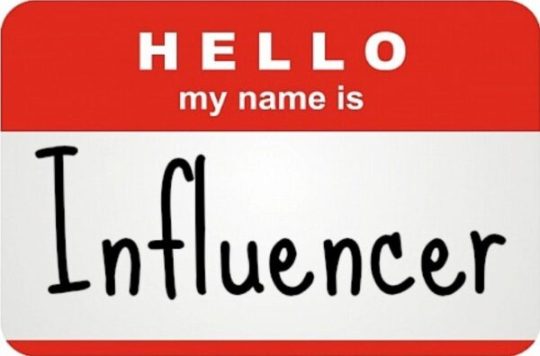
Here’s how it works: They’ll join a DJ school, and take a few lessons on dropping, mixing and scratching. The next thing you know, they’re influencers, telling aspiring DJs — who genuinely want to learn the art form — what kind of gear to buy, and what apps to run while DJing. If an economically challenged kid from the Bronx can’t afford that $3,000 laptop, or can’t drop $2,000 on the latest mixer, well, they inform them, they’ll just be “left in the dust.”
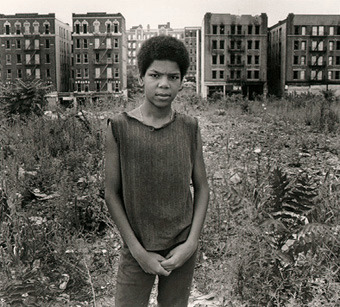
The indecency of it all is this: People who listen to these influencers have no awareness they are, effectively, being colonized. They do not know the very worldview being pushed upon them — that they will be banished if they can’t keep up economically — serves the function of making their ultimate elimination look benign. They do not know these are outsiders, who’ve successfully infiltrated hip-hop, specifically DJ culture, bearing gifts; ones who are, at every second, exploiting it, and them, for monetary gain.
So, here we are. It’s the opening month of the year marking hip-hop’s 50th anniversary; another year overgrown with “DJs” turned influencers. These are the ones who don’t respect hip-hop’s legacy of economic inclusion, this being a philosophy embedded in the culture by the pioneers on whose shoulders we stand.
At this point, what am I saying should be done?
I’m suggesting the following two (2) action steps.
If you’re going to become a DJ, or teach DJing:
• Examine our culture first. Interact with it. Learn its history, document it, and teach it correctly, to others. Name its great artists and tell what they did to advance the art form. Don’t merely and unethically profiteer off hip-hop’s resources for “LIKES”, “FOLLOWS,” and Benjamins.
• Refrain from using fear-mongering tactics to attract students, or to cash in on DJing, and the greater culture of hip-hop.
In closing:
This essay grew out of a social media conflict I’ve been having over specific forms of marketing, aimed at students of the culture. As should be clear, I strongly object to these practices.
This is not a statement against any person, or group of persons. Further, this is not a statement against the people who follow my work, or, especially, the ones who don’t.
If you are a true supporter of hip-hop culture — not the rah-rah around it, but the science and history of it — I thank you. I particularly thank you if that interest has led you to give an ear to what I have ever said or done.
I stand on all the above. If, because of what I’ve said, I lose colleagues, followers, students, sponsorships or should I be slandered, vilified, shunned or become abject, while it would be unfortunate, I do not care. I am aligned with a much Higher Power, and higher values, than those with which the current DJ world aligns itself.
I stand firm in the truth of my words, even if they are disconcerting, because I understand the following: There is an economic and creative war, happening in plain sight, for the control of how people think and interact, not only with DJ art and technology, but with themselves, and with their own minds.
For that reason, I’ll never go along with fake shit, to get along with fake shit. Instead, I dig in my heels for what I see as right and just.
Regardless of the circumstances, I will always stay, and reside, in truth and in respect. That is the legacy of the pioneers, and, as far as my part is concerned, understand: I’m just trying to help this art form get to the next generation, intact.
Happy 50th, hip-hop.

If you’re interested in scheduling an appointment or you’d like more information, please contact us.
0 notes
Link
1 note
·
View note

